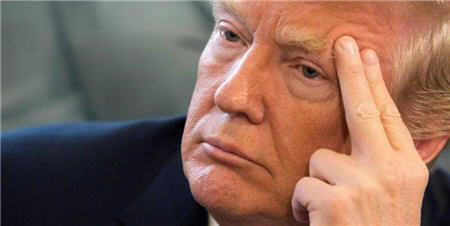By Cullen Hendrix — The Mark News —
In his first year, Trump’s “America First” policy agenda has extended to energy policy, to the detriment of the environment both at home and abroad.

On the campaign trail, U.S. presidential candidate Trump promised to revive the coal industry and make United States energy independent, no matter the cost to the environment, or to attempts to combat climate change.
However, one year into his administration, President Trump’s “America First” energy and natural resource policies have resulted in few real gains for U.S. coal producers. But these minimal-at-best gains have come at the cost of broader trade disputes that threaten the U.S. economy and national security.
Trump has been determined to push the United States toward energy self-sufficiency and boost coal-fired electricity production. Several policy initiatives, including rolling back environmental regulations and slapping tariffs on imported solar panels, have been designed to do just that.
Toward the end of his first year in office, Trump trumpeted his success in lifting restrictions on American energy, “including shale, oil, natural gas and clean, beautiful coal, of which we have 1,000 years of supply.” Even Trump’s withdrawal of the United States from the Paris Agreement on climate change mitigation was a signal that his would be a presidency defined by the return of “homegrown” energy.
These policies are guided by two assumptions.
The first, that coal is unfairly shackled by regulation, and a healthy coal industry free of environmental restrictions will restore the U.S. economy – and the coal-producing regions of Kentucky, Pennsylvania and West Virginia which voted so decisively for Trump – to prosperity and glory.
The second, that energy self-sufficiency will allow the U.S. to recoil from international energy geopolitics, avoiding entanglements in the Middle East and elsewhere. To the extent Trump has an identifiable worldview, it is that the pursuit of self-sufficiency means freedom of action and freedom from consequence.
The first assumption rests on faulty logic. The U.S. coal industry is in decline not because of environmental regulation, but because a better option – in the form of lower-cost natural gas and solar – is driving down demand. Coal industry employment is in decline for these reasons and because productivity gains mean fewer workers are needed to produce the same amount of coal. Put simply, technological advancement, not environmental regulation, is putting coal out of business.
Just as the Stone Age didn’t end because we ran out of stones, the coal age won’t end because we run out of coal. U.S. coal production peaked in the late 2000s; coal employment will never return to the pre-1980 levels, regardless of how much coal is in the ground.
This second assumption is even more illogical. Even if the United States were to become completely energy self-sufficient, its major global partners would not. Key U.S. allies and lynchpins of the global economy – China, Japan, the European Union – will remain dependent on global markets for the foreseeable future.
The U.S. economy’s health depends on the health of its major trading partners and allies. U.S. security interests will continue to track developments in global energy markets. This will be true, regardless of whether the U.S. is a major importer or exporter of energy.
Moreover, the pursuit of self-sufficiency is coming at real costs that heighten, rather than lessen, international tensions.
Take the solar example. In January 2018, and in a misguided attempt to create better margins for coal and U.S.-based solar panel producers, Trump imposed a 30 percent import tariff on solar panels, the majority of which come from China. Thus, solar energy became the first real salvo in what appears to be a growing trade skirmish – if not war – with China. Such a war would harm consumers and producers in both countries while hazarding broader conflict.
Finally, the rise of the United States as an energy exporter may itself create more political instability. U.S. supply is helping to drive down energy prices, putting pressure on oil-exporting countries to diversify their economies and provide meaningful opportunities for their young populations. Many nations, most notably the OPEC countries, have depended on high oil prices, market position and the protection from threats that their market power has conferred.
Low energy prices drive unrest in these exporting countries. The Trump administration has scarcely been able to avoid war in Syria – do we honestly think he would be able to ignore broader turmoil in the Arabian Peninsula? Given that U.S. allies and trade partners still rely on these producers, trouble there would almost surely draw U.S. interest. While lower energy prices would be a good start, the risk of political instability in oil-exporting economies is too great.
In his first year, Trump’s “America First” policy agenda has extended to energy policy, to the detriment of the environment both at home and abroad. Moreover, the pursuit of energy independence has come with real costs and unanticipated consequences that will leave the United States – and the world, by extension – less secure.
 Dr. Cullen Hendrix is Associate Professor at the Sié Chéou-Kang Center for International Security and Diplomacy at the Korbel School of International Studies, University of Denver. He is also Nonresident Senior Fellow at the Peterson Institute for International Economics, and Senior Research Advisor at the Center for Climate & Security. His book, Confronting the Curse: The Economics and Geopolitics of Natural Resource Governance (with Marcus Noland), was published in 2014.
Dr. Cullen Hendrix is Associate Professor at the Sié Chéou-Kang Center for International Security and Diplomacy at the Korbel School of International Studies, University of Denver. He is also Nonresident Senior Fellow at the Peterson Institute for International Economics, and Senior Research Advisor at the Center for Climate & Security. His book, Confronting the Curse: The Economics and Geopolitics of Natural Resource Governance (with Marcus Noland), was published in 2014.






Fine article, but that should be “linchpins” of the global economy, not “lynchpins” (10th paragraph).